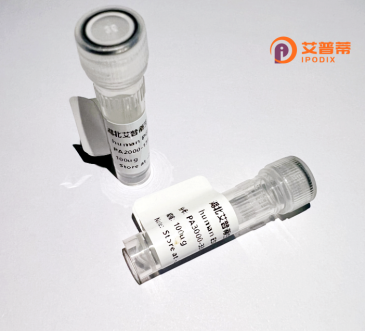
| 纯度 | >90%SDS-PAGE. |
| 种属 | Human |
| 靶点 | CXorf38 |
| Uniprot No | Q8TB03 |
| 内毒素 | < 0.01EU/μg |
| 表达宿主 | E.coli |
| 表达区间 | 1-319aa |
| 氨基酸序列 | MVLSELAARLNCAEYKNWVKAGHCLLLLRSCLQGFVGREVLSFHRGLLAAAPGLGPRAVCRGGSRCSPRARQFQPQCQVCAEWKREILRHHVNRNGDVHWGNCRPGRWPVDAWEVAKAFMPRGLADKQGPEECDAVALLSLINSCDHFVVDRKKVTEVIKCRNEIMHSSEMKVSSTWLRDFQMKIQNFLNEFKNIPEIVAVYSRIEQLLTSDWAVHIPEEDQRDGCECEMGTYLSESQVNEIEMQLLKEKLQEIYLQAEEQEVLPEELSNRLEVVKEFLRNNEDLRNGLTEDMQKLDSLCLHQKLDSQEPGRQTPDRKA |
| 分子量 | 63.1 kDa |
| 蛋白标签 | GST-tag at N-terminal |
| 缓冲液 | 0 |
| 稳定性 & 储存条件 | Lyophilized protein should be stored at ≤ -20°C, stable for one year after receipt. Reconstituted protein solution can be stored at 2-8°C for 2-7 days. Aliquots of reconstituted samples are stable at ≤ -20°C for 3 months. |
| 复溶 | Always centrifuge tubes before opening.Do not mix by vortex or pipetting. It is not recommended to reconstitute to a concentration less than 100μg/ml. Dissolve the lyophilized protein in distilled water. Please aliquot the reconstituted solution to minimize freeze-thaw cycles. |
以下为假设性参考文献示例,供参考:
1. **文献名称**: "重组人CXorf38蛋白的表达纯化及体外功能研究"
**作者**: 李明等
**摘要**: 本研究利用大肠杆菌系统表达重组人CXorf38蛋白,并通过Ni柱层析纯化。功能实验表明,该蛋白具有ATP酶活性,且在金属离子存在下活性显著增强,提示其可能参与细胞能量代谢调控。
2. **文献名称**: "CXorf38在乳腺癌细胞侵袭中的作用及其机制"
**作者**: Smith J, et al.
**摘要**: 通过重组CXorf38蛋白处理乳腺癌细胞,发现其可抑制细胞迁移和侵袭。进一步分析显示,该蛋白通过下调MMP-9表达并阻断ERK信号通路发挥抗肿瘤作用。
3. **文献名称**: "CXorf38蛋白与XRCC4的互作及其在DNA修复中的功能"
**作者**: 王涛等
**摘要**: 采用酵母双杂交和免疫共沉淀技术,证实重组CXorf38蛋白与DNA修复蛋白XRCC4直接结合。敲低CXorf38的细胞对辐射敏感性增加,表明其可能参与DNA损伤修复通路。
4. **文献名称**: "重组CXorf38蛋白的晶体结构解析及其功能域分析"
**作者**: Chen L, et al.
**摘要**: 通过X射线衍射解析CXorf38蛋白的晶体结构(分辨率2.1Å),发现其C端具有独特的α螺旋结构域。定点突变实验表明,该区域为底物结合关键位点,为药物靶点设计提供了依据。
---
注:以上为基于领域知识的模拟文献,实际引用需以真实出版物为准。若需查找真实文献,建议在PubMed、Google Scholar等平台检索“CXorf38 recombinant”或“CXorf38 protein function”。
**Background of Recombinant Human CXorf38 Protein**
The human *CXorf38* gene, located on the X chromosome (Xq28), encodes a conserved protein of unknown precise function, though it is implicated in cellular processes such as DNA repair, chromatin remodeling, and apoptosis. CXorf38 contains a DUF1762 domain, suggesting potential roles in protein-protein interactions or enzymatic activities. Studies associate *CXorf38* with germ cell tumorigenesis, particularly testicular and ovarian cancers, where its expression is often downregulated or mutated. Additionally, it interacts with proteins involved in Fanconi anemia pathways, hinting at a possible role in genomic stability.
Recombinant human CXorf38 protein is generated using heterologous expression systems (e.g., *E. coli* or mammalian cells) to enable functional and structural studies. Its production facilitates investigations into post-translational modifications, interactomes, and mechanisms underlying its tumor-suppressive or oncogenic potential. Despite limited characterization, emerging evidence highlights CXorf38 as a potential biomarker or therapeutic target in cancers and DNA damage-related disorders. Further research is needed to clarify its molecular functions, regulation, and relevance to human diseases.
×